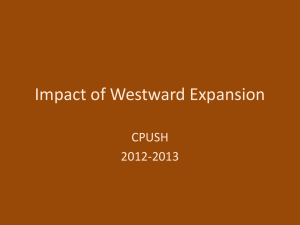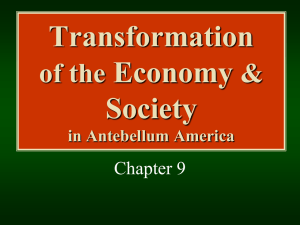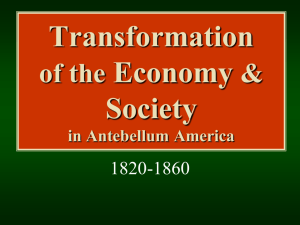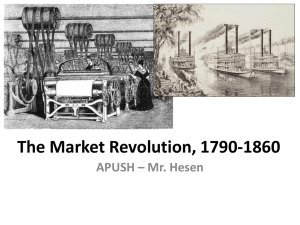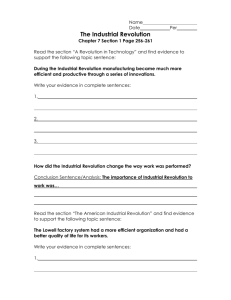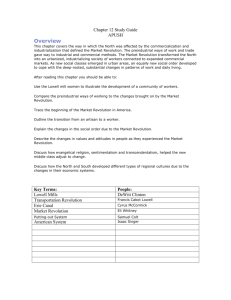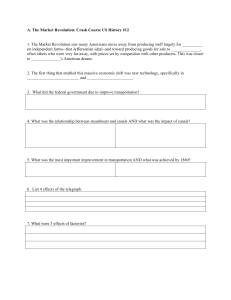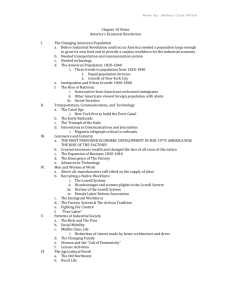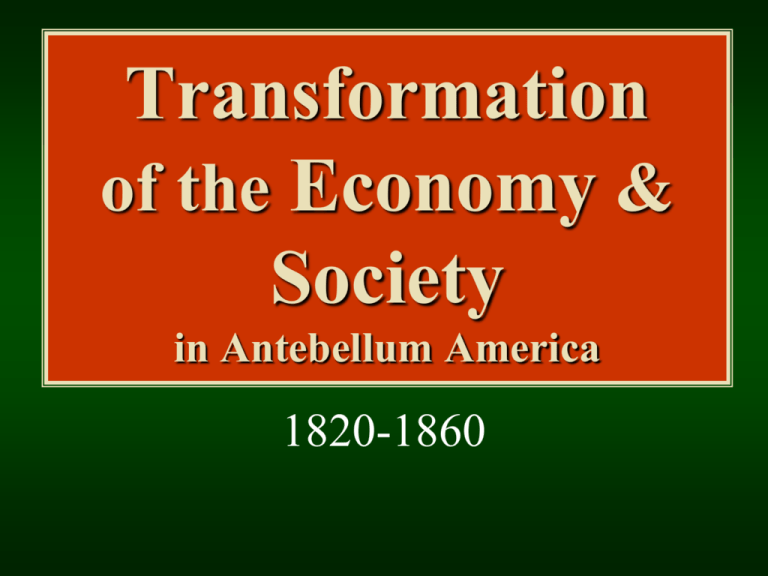
Transformation
of the Economy &
Society
in Antebellum America
1820-1860
Guiding Question
Analyze the causes of the
transformation of the American
economy in the first half of the
nineteenth century.
Include: developments in transportation,
population, manufacturing and agriculture.
THE TRANSPORTATION REVOLUTION &
CREATION OF A NATIONAL MARKET ECONOMY
agrarian economy
Market Revolution
Key catalysts:
(1) transportation improvements – canals, RRs
(2) development of textile mills and factories
(3) innovations in banking and legal practices
(4) Capital – from Europe (esp. Britain)
(5) Population growth – 9M in 1820 → 30+M in 1860
Not Yet the Industrial Revolution
TRANSPORTATION
REVOLUTION
& THE CREATION OF A NATIONAL
MARKET ECONOMY
Eras of Transportation
Turnpike & River Era
Canal
Era
Railroad Era
Automobile Era
1790s-1820s
1825-1840s
1850s-1940s
1920s-present
TRANSPORTATION REVOLUTION
turnpikes
National Road
TRANSPORTATION REVOLUTION
Steamboats
– Robert Fulton
– Clermont (1807)
Impact on
transportation and
trade
Robert Fulton’s Clermont plies the
Hudson River
TRANSPORTATION REVOLUTION
Erie Canal (1825)
Significance
– Cost of trade
– Direction of trade
– Settlement of NW
– New York City
– Upstate NY
– Canal boom
TRANSPORTATION REVOLUTION
Principal Canals in 1840
Roads and Canals, 1820-1850
• Canal boom
• Effect on transportation and
trade patterns
Paths of Northern Migration after 1800
TRANSPORTATION REVOLUTION
Railroads
Baltimore &
Ohio RR (1830)
short lines
trunk lines
Mohawk And Hudson Railroad’s Dewitt Clinton
National
Market
Economy:
Inland
Freight Rates,
1790-1865
National Market
Economy:
The Speed of
News in 1817
and 1841
TRANSPORTATION REVOLUTION
Impact of Railroads
a) Promoted national trade and economic growth
b) Linked Northeast and old Northwest for trade
• Consolidation of early short lines leads to E-W orientation
• Chicago
c) Promoted the growth of other industries
• Iron
• Coal
• Telegraph
d) Encouraged farmers to specialize
e) First great corporations in US – model for later large
businesses
BEGINNINGS OF
INDUSTRIALIZATION
&
CHANGES IN SOCIAL
AND CLASS
STRUCTURES
BEGINNINGS OF
INDUSTRIALIZATION
Factory System
Rise of Corporations
Technological Innovations
Labor
Old Northwest
BEGINNINGS OF INDUSTRIALIZATION
textiles
Samuel Slater
factory system
Samuel Slater
(“Father of the
Factory System”)
BEGINNINGS OF INDUSTRIALIZATION
Lowell (or Waltham) Factory System
– Francis Cabot Lowell
– First dual-purpose textile plants
– employees
Lowell towns
Lowell, Mass. in 1850
New England Textile
Centers: 1830s
Middlesex Company Woolen Mills, Lowell, Massachusetts, c. 1848, artist unknown
Middlesex Company Woolen Mills, Lowell, Massachusetts, c. 1848, artist unknown
Copyright © Houghton Mifflin Company. All rights reserved.
Lowell Girls
Lowell Girls
Early
Textile
Loom
• Lowell Girls - typical “profile”
• Factory Girls Association
Lowell Boarding Houses
The Growth of Cotton Textile Manufacturing, 1810–1840
BEGINNINGS OF INDUSTRIALIZATION:
Legal and Financial Developments
Corporations
– In 1800, c. 20 corps US; by 1817, over 1800
– General incorporation laws
• New York, 1848
– stock
– limited liability
Banking – paper banknotes
2. INVENTIONS &
INNOVATIONS
Americans were willing to try anything.
They were first copiers, then innovators.
•Patents Approved:
•1800: 41
•1860: 4,357
Eli Whitney: The
Cotton Gin, 1791
(Actually invented
by a slave)
Eli Whitney’s Gun Factory
Interchangeable Parts Rifle
John Deere & the Steel Plow
Cyrus McCormick
& the Mechanical Reaper
Samuel F. B. Morse
1840 – Telegraph
Cyrus Field
& the Transatlantic Cable, 1858
Elias Howe & Isaac Singer
1840s
Sewing Machine
Distribution of Wealth
During the American Revolution,
45% of all wealth in the top 10% of
the population.
1845 Boston top 4% owned over
65% of the wealth.
1860 Philadelphia top 1% owned
over 50% of the wealth.
The gap between rich and poor was
widening.
3. WORKFORCE & LABOR
Skilled artisans vs.
unskilled workers
working class
Immigrant work
force
The Factory Girl’s Garland
February 20, 1845 issue.
3. LABOR & THE EARLY UNION
MOVEMENT
craft societies
National Trades’ Union
Early issues:
– Child Labor Laws
– 10 Hour Workday
– Right to Strike
Commonwealth v. Hunt (Massachusetts,1842)
Early unions were usually local, social, and weak
– and were largely ineffective before the Civil War
4. RISE OF AN AGRICULTURAL
ECONOMY IN (OLD) NORTHWEST
Northeastern Agriculture vs. The Old
Northwest
• Decline in Northeast
• Rise of the Midwest
• Ties between Northeast and old Northwest
CHANGES IN
SOCIAL AND
CLASS
STRUCTURES
Guiding Question
How did the transformation of
the American economy in the
first half of the nineteenth
century bring about changes to
society, including the role of
women?
CHANGES TO SOCIETY
The market economy changed:
class structure
The nature and location of work
Gender roles (Middle class)
the standard of living
Social Class structure
Working class
Rise of the middle class
Social mobility?
Geographic mobility
UPPER
MIDDLE
WORKING
LOWER
Where do Farmers fit?
CHANGES TO
SOCIETY
Work & Home
Lower birthrates
“Separate Spheres”
– end of cottage industry
– new gender roles
“cult of domesticity”
employment opportunities
Education of women
– Oberlin College
Occupations of Women Wage
Earners in Massachusetts, 1837
POPULATION GROWTH,
IMMIGRATION AND
NATIVIST REACTION
Guiding Question
“Throughout its history, the United
States has been a land of refuge and
opportunity for immigrants.”
Assess the validity of this statement in
view of the experiences of the English,
Germans, & the Irish in the 19thcentury urban Northeast.
POPULATION GROWTH
1775
1790
1820
1840
1860
2.5 Million
4 Million
10 Million
17 Million
32 Million
POPULATION GROWTH
Causes
Natural increase
Immigration
Immigration to the
United States, 1820-1860
Immigration
Major immigrant groups
Irish
Germans
English
When did they come?
Where did they settle?
National Origin
of Immigrants:
1820 - 1860
Immigration
to the United
States, 18201860
Participation of Irish and German Immigrants in the New
York City Workforce for Selected Occupations, 1859
The distribution of foreign-born residents of the
United States in 1860.
Immigration & Nativism
nativism
Native American Association
Supreme Order of the Star
Spangled Banner
American (“Know-Nothing”)
Party
Recent immigrants, from
Harper’s Weekly, 1858
ECONOMIC?
POLITICAL?
SOCIAL?
FUTURE
PROBLEMS?

